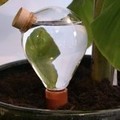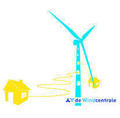Winners of Designing Recovery Competition
by: Sustainable Design News, 2013-10-07 00:10:55 UTC

The American Institute of Architects (AIA) revealed the winners of the Designing Recovery competition.
 Biomimetic Vascular Solar Cells
Biomimetic Vascular Solar Cells
by: Eco Geek Latest, 2013-10-09 12:09:26 UTC

Researchers at North Carolina State University have come up with a new way of making solar cells with a method that uses circulation much like that in plant leaves to maintain the efficiency of the cells.
Dye-sensitized solar cells (DSSC) are organic cells that use light-sensitive dyes to generate electricity. These cells could eventually make low-cost and more environmentally-friendly collectors for solar energy, but until now, the problem has been that the dyes eventually break down due to ultraviolet rays from the sun and lose their efficiency.
The NCSU scientists have created a cell with vascular chanels, much like the veins in a leaf, to allow them to replenish the dye and thereby maintain the efficiency of the cell. Lead author Prof. Orlin Velev describes the process: “We considered how the branched network in a leaf maintains water and nutrient levels throughout the leaf. Our microchannel solar cell design works in a similar way. Photovoltaic cells rendered ineffective by high intensities of ultraviolet rays were regenerated by pumping fresh dye into the channels while cycling the exhausted dye out of the cell. This process restores the device’s effectiveness in producing electricity over multiple cycles.”
DSSCs are made with "a water-based gel core, electrodes, and inexpensive, light-sensitive, organic dye molecules that capture light and generate electric current." The simpler, non-metallic makeup of these cells could make them less expensive to produce, and could mean less extraction of rare minerals required in order to continue to provide solar energy.
via: Cleantechnica
 TED: Jeff Speck: The walkable city - Jeff Speck (2013)
TED: Jeff Speck: The walkable city - Jeff Speck (2013)
by: TEDTalks (video), 2013-10-14 15:19:17 UTC
How do we solve the problem of the suburbs? Urbanist Jeff Speck shows how we can free ourselves from dependence on the car -- which he calls "a gas-belching, time-wasting, life-threatening prosthetic device" -- by making our cities more walkable and more pleasant for more people.
 TED: Xavier Vilalta: Architecture at home in its community - Xavier Vilalta (2013)
TED: Xavier Vilalta: Architecture at home in its community - Xavier Vilalta (2013)
by: TEDTalks (video), 2013-10-25 15:00:08 UTC
When TED Fellow Xavier Vilalta was commissioned to create a multistory shopping mall in Addis Ababa, he panicked. Other centers represented everything he hated about contemporary architecture: wasteful, glass towers requiring tons of energy whose design had absolutely nothing to do with Africa. In this charming talk, Vilalta shows how he champions an alternative approach: to harness nature, reference design tradition and create beautiful, modern, iconic buildings fit for a community.
 Furniture Building Tips: How to Remove Dents and Holes in Wood Using Steam
Furniture Building Tips: How to Remove Dents and Holes in Wood Using Steam
by: Core77, 2013-10-31 17:30:00 UTC

Furniture builders who distress wood have their own sets of tricks. We've seen bike chains, bottlecaps, and even beloved, uniquely-shaped rocks all used to bang antique-looking dents into tabletops and the like. But how about getting accidental dents out of a wood surface? Or even mis-drilled holes? There is a pretty magical way to fix them. Use a steamer.
For a video demonstration of how to do this, we look to woodworking expert and addict Izzy Swan, the maniac who figured out how to turn wooden balls using a circular saw. In the video below, Swan demonstrates how to take an average, $20 steamer and use it to apply steam for a few minutes to screw holes in wood. After steaming, he lets the board dry for about 30 minutes and quite incredibly, the holes are practically non-existent. He also shows how you can remove dents in wood by applying a damp rag to the dent and then running a hot iron over it for only two minutes.
Now, why does this process work?
(more...) Ecopods Shipping Container Houses
Ecopods Shipping Container Houses
by: Jetson Green, 2013-10-31 10:29:16 UTC

The Canadian firm Ecopods makes sustainable, fully recycled short term container dwellings. Ecopods are an excellent choice as cabins, guesthouses or other accessory buildings, or showrooms. All ecopods houses are designed to function off the grid, and can easily be transported anywhere.
Power to the ecopod is supplied via a 80 watt solar panel and 12 volt battery, which eliminates any need to run power lines or trench power cables to the unit, meaning that it is ready to live in right after set up. One of the 20-foot side walls of the ecopod can be lowered by 2 hydraulic cylinders to form a sturdy deck. This wall is lowered with the use of a solar-powered electric winch. The deck can be raised to secure the ecopod when leaving the dwelling for a longer period of time.

The outer shell and structure of an ecopod is made from a standard 8’x20’ steel shipping container. For the interior walls the Magnesiacore Technology is used. This technology uses proprietary processes with magnesium oxide compounds to deliver a multi-purpose, non-combustible, and versatile board material, which provides full LEED credit for all uses. Magnesiacore boards are made primarily from Magnesium Oxide (MgO), which is a naturally occurring compound.
The wall insulation of ecopods is soy-based and water-blown into walls and ceiling cavities to provide the needed thermal protection to the home. This type of insulation contains no formaldehyde or other harmful and irritating matter. It is also mold resistant and is not a food source for rodents or insects. This type of insulation is also Class 1 fire rated, meaning it will char but won’t sustain a flame. The soy-based insulation gives the ecopod an airtight seal, and the 1” inch insulation used gives the house walls an R-value of R-9.


The interior walls are finished with Supertherm, which features a combination of high performance aliphatic urethanes, elastomeric acrylics, resin additives and standard acrylics in a water borne formula. This finish contains no co-solvents and dries by evaporation. Supertherm is also made with four separate ceramic compounds for insulation from radiant heat, reflection, conduction and convection. The Supertherm is applied over the Magnesiacore wall panels and raises the ecopods’ R value to R-28.
The floors of ecopods are covered by ECOsurfaces flooring which is made of recycled tire rubber and ColorMill EPDM, which is comprised of pre-consumer waste and organic fillers. Together these two materials form a water based polyurethane polymer. The resulting flooring has low-VOC emissions and is recyclable and can contribute toward earning 9 LEED points.
Ecopods are also equipped with Sun-Mar composting toilets, which evaporate the water from the toilet waste and carry it back to the atmosphere via a specially designed vent system. The household water needs are taken care of by a WaterMill, which is an atmospheric water collection device that works to condense water vapor, while also purifying it. This system works by drawing in moist, outside air through an air filter. This air then passes over a cooling element, and condenses the moist air into water droplets. These are then collected and pass through a specialized carbon filter, which is finally exposed to an ultraviolet sterilizer that eliminates all bacteria to provide drinking water.
 Economic crisis not the main cause of the EU's CO2 drop, researchers say
Economic crisis not the main cause of the EU's CO2 drop, researchers say
by: Euractive, 2013-10-31 07:56:23 UTC
Contrary to widespread belief, including at the European Commission, the massive uptake of renewable energies since 2005 has had a greater impact on the reduction of CO2 emissions than the economic slowdown.
A small sentence slipped into a report published by the European Commission in November 2012 stated that “the economic crisis was clearly the major cause of a significant reduction in CO2 emissions”.
But the assertion, which has been widely accepted and repeated by policymakers, now appears false.
According to CDC Climat, an investment group owned by France's sovereign wealth fund, the Caisse des Dépôts, the economic slowdown did not play such a decisive part in the reduction of carbon emissions. Rather, it is the rapid spread of wind-farms and solar panels in electricity production that was more significant in reducing carbon emissions in Europe since 2005.
“The good news is that we believe that CO2 emissions in Europe have declined by about 1.1 gigatons of CO2 since 2005," says Emilie Alberola, who heads CDC Climat's carbon market and energy practice.
"But energy policies in Europe came into conflict: the massive appearance of renewables has undermined the carbon market," says the researcher.
Part of the problem is the energy and climate change "package" of EU legislation adopted in 2009. The package included a series of measures to reduce CO2 emissions by 20% by 2020, while pushing up the share of renewable energy to 20% of the energy mix and increasing energy efficiency by 20%. The roadmap is well on track, according to the European Environment Agency except for the energy efficiency side.
>> Read: Efficiency lags behind in EU's triple energy target
However, the rapid development of renewable energies came as a surprise, a situation that was helped by favourable tax regimes in most European countries.
According to Eurostat, electricity generated from renewable sources rose from under 14% to over 20% of the total in Europe between 2005 and 2011. Photovoltaic panels in the South and wind turbines in the North have revolutionised the European energy mix.
According to the calculations of CDC Climat, these new energies alone explain half of the carbon savings since 2005, representing 500 million tons of avoided CO2 emissions. The economic slowdown, for its part, contributed a smaller share of emissions reduction, estimated at 300 million tons of carbon. This is certainly more important than progress registerd on energy efficiency (-100 to -200 million tons).
The bottomline is that the contribution of the economic crisis in lowering carbon emissions is lesser than initially thought.
These positive developments are not without their casualties however, with the EU's carbon market plummeting. Carbon prices have played a part in reducing emissions but their main effect was to promote fuel switching, from coal to gas. The EU carbon market also helped to reduce emissions outside of Europe, thanks to the so-called "flexible mechanisms" foreseen under the Kyoto Protocol.
But in the end, the carbon market was neutralised by the weakness of the CO2 emissions in Europe, which led to an artificial abundance of emission quotas in circulation. The carbon price has fallen to zero first in 2008, before going up to nearly €30 per ton in 2009. They currently hover around €6 per ton.
Efficiency of European policies put into question
This is where the CDC Climat study raises the question of the effectiveness of European policies.
The introduction of the carbon market comes at a cost, just like energy efficiency measures or the installation of wind turbines. Chasing the three 2020 objectives simultaneously - 20% renewables, 20% CO2 reduction and 20% energy savings - like the European Commission intended, ended up being self-defeating.
In the meantime, environmentalists are sure to note the low correlation between CO2 levels and growth highlighted in the CDC Climat study. The relationship is not linear, since economic growth may stagnate without causing drastic changes in greenhouse gas emissions.
Meanwhile, the goal of a 30% reduction of CO2 emissions currently under discussion at European level, does makes sense, according to the CDC Climat study. On the one hand the 2020 goal has almost already been reached, seven years ahead of the deadline, since CO2 emissions have fallen by 18% since 1990.
Secondly, CDC says the argument of economic growth, the main political argument against a more ambitious climate policy, no longer seems to hold.
New Hyperloop Startup Announces it Will Build a Prototype by Next June
by: Inhabitat , 2013-10-31 21:56:43 UTC

The Hyperloop concept is already beginning to pick up speed. A new start up group of engineering experts, who call themselves Hyperloop Transportation Technologies Inc., has stepped forward with the ambitious task to turn Elon Musk’s idea into reality. Today the team’s leading technicians, Dr. Marco Villa, former SpaceX mission director, and former president of the American Society of Civil Engineers Dr. Patricia Galloway, along with HTT interim CEO Dirk Ahlborn announced their plan to build a prototype Hyperloop system by next year.




Read the rest of New Hyperloop Startup Announces it Will Build a Prototype by Next June
Permalink | Add to del.icio.us | digg
Post tags: Dirk Ahlborn, Electric Transporation, elon musk, Fringe Tech, Future Tech, GloCa, Hyperloop, Hyperloop Concept, hyperloop development, Hyperloop Transportation Technologies, JumpStartFund, Marco Villa, Patricia Galloway, Space X, SuprStudio, tesla, ULCA





 you&me Creates an Interactive Art Exhibit in Greece from Reclaimed Materials
you&me Creates an Interactive Art Exhibit in Greece from Reclaimed Materials
by: Inhabitat , 2013-10-28 21:00:49 UTC

you&me collaborated with the Greek artist and sculptor, Dionysis Papadatos to create an interactive exhibition of his works at the Kryti Cultural Centre in Zakynthos, Greece. The exhibition explores themes of natural and artificial landscapes, creating playful and immersive juxtapositions both within the exhibition space itself and in the surrounding landscape of the olive grove. The concept for the exhibition takes cues Krypti’s identity, and wayfinding is curated as a game of ‘Hide and Seek’. The visitor’s experience starts inside the exhibition building where the artworks sit on cut tree trunk plinths, and then continues outside. Artworks are found following a trail of brightly colored insertions. A series of picture frames compose new views and draw you to the exhibits; a sky blue ladder takes you to an artwork perched on an olive branch; an acid yellow trunk reveals another; a seminar table hosts workshops; and two stools made from olive oil tanks invite you to sit and discuss. The materials from the exhibition are entirely recycled. The exhibit will be open until November 14, 2013.
+ you&me Architecture



The article above was submitted to us by an Inhabitat reader. Want to see your story on Inhabitat? Send us a tip by following this link. Remember to follow our instructions carefully to boost your chances of being chosen for publishing!
Permalink | Add to del.icio.us | digg
Post tags: artificial landscapes, Greek artist, interactive exhibition, Kryti Cultural Centre, Recycled Materials, sculptor Dionysis Papadatos, you&me





 Ecovative's magical mushroom insulation wins 2013 Buckminster Fuller Challenge
Ecovative's magical mushroom insulation wins 2013 Buckminster Fuller Challenge
by: TreeHugger Design, 2013-10-23 13:52:00 UTC

The styrofoam substitute that they grow into packaging and insulation is the next big thing in building.










Comments by our Users
Be the first to write a comment for this item.